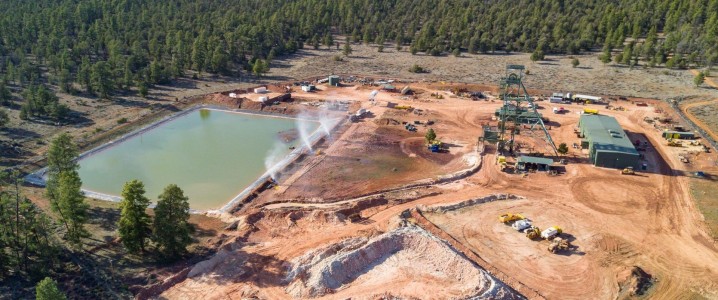The nuclear power industry will need additional uranium supply in the medium and long term to ensure adequate supply for the new era of nuclear energy.
Therefore, efforts must begin immediately to secure the supply of the key nuclear fuel, the OECD Nuclear Energy Agency (NEA) and the International Atomic Energy Agency (IAEA) said in their Red Book report prepared jointly every two years.
Nuclear energy has been booming since 2022 as many countries seek to add reliable but zero-carbon electricity generation capacity to meet growing power demand, including from AI and data centers. The complex geopolitical background in uranium supply could present challenges to some countries ensuring uranium for their nuclear power plants.
Investment in New Uranium Supply Needs To Grow
Global uranium production has rebounded since its low point in 2020 and 2021, and the current supply is sufficient, the report said. But the expected strong nuclear power growth in the coming decades needs investments in supply now, so that production could begin in a few years, given the long lead times from a project on the drawing board to actual mining and uranium processing operations.
“Sufficient uranium resources exist to support both the continued use of nuclear power and its significant growth through 2050 and beyond,” the report said.
Related: U.S. Shale Faces Toughest Challenge Since the 2020 Oil Price Plunge
“However, timely investments in new exploration, mining operations and processing techniques will be essential to ensure that uranium becomes available to the market when needed,” the authors of the Red Book added.
Following five years of declining production as major producing countries, including Canada and Kazakhstan, limited production in response to a depressed uranium market, production began to increase in 2022 in response to a strong uranium price recovery. This trend continued in 2023 and 2024, according to the report.
Kazakhstan remains by far the world’s largest producer, at 43% of global uranium production. In 2022 alone, Kazakhstan’s production was more than the combined production from the next four top producers, Canada, Namibia, Australia, and Uzbekistan.
Kazakhstan has boosted sales to Russia and China in recent years, although it keeps selling uranium to Western countries as it prefers to keep its uranium sales markets diversified.
Nuclear Capacity Set to Soar
The Red Book report expects global nuclear capacity to jump by 45% by 2050 compared to 2022 in the low demand case. The surge in the high-demand case is seen at 130%, suggesting that the global uranium fleet could more than double by 2050.
The rise could be even higher considering that this estimate in the biennial report takes into account policies and plans of January 1, 2023. In the two years since then, more countries have announced plans to return to nuclear power or boost nuclear generation capacity.
Amid plans for expansion in many countries, including in the United States, uranium demand is set to surge in the coming years and decades, while Western companies are seeing increased competition from China and Russia for supply.
Moreover, the biggest technology firms have started to back next-generation nuclear, hoping to have 24/7 zero-carbon energy power their data centers.
Many start-ups in the United States and Europe are vying to become the first to not only design but also put into commercial operation the next generation of advanced nuclear reactors, the so-called small modular reactors (SMR).
Nuclear power will be one of the most important new energy infrastructures that the world will need to meet the electricity demand from AI, Goldman Sachs said in a report earlier this year.
Investment Dilemma
While uranium resources will be enough to meet the nuclear power growth, even in the high-growth scenario, for a few more decades, the world needs to start investing now in new exploration, mining, and processing of uranium, according to the Red Book report.
“The uranium resource base is sufficient to meet the needs of a high-growth nuclear capacity through 2050 and beyond. However, this will require essential investments in new exploration, improved processing techniques and new production centres to replenish reserves,” the authors of the report noted.
Investment, however, isn’t easy to come by, especially when uranium prices aren’t supportive.
Just this week, Australian uranium miner Deep Yellow deferred the final investment decision for its Tumas project in Namibia “until improved uranium price incentive supports greenfield project development.”
“The demand outlook is undeniable, driven by decarbonisation efforts, forecasts of continued enormous energy demand growth, the prevailing structural supply shortages and now having to deal with the added, newly emerging requirements from the developers of energy hungry datacentres, give clear upside for the supply sector,” said John Borshoff, Deep Yellow’s managing director.
But he noted that “The reality is there are limited greenfield uranium deposits available for start-up globally over the next 10 years to satisfy projected demand, and new uranium supply will be virtually impossible to achieve in the current price environment.”
According to Borshoff, “Nuclear utilities cannot ignore the fact that unless uranium prices increase to appropriate levels and large amounts of capital become available to the supply sector, those greenfields projects will remain undeveloped.”
By Tsvetana Paraskova for Oilprice.com
More Top Reads From Oilprice.com
- Cautious Calm in Canada’s Oil Patch as Prices Slide
- Consumer Prices Unexpectedly Drop as WTI Plunges by Over 4%
- Shell Starts Production at Dover Field in Gulf of Mexico


















